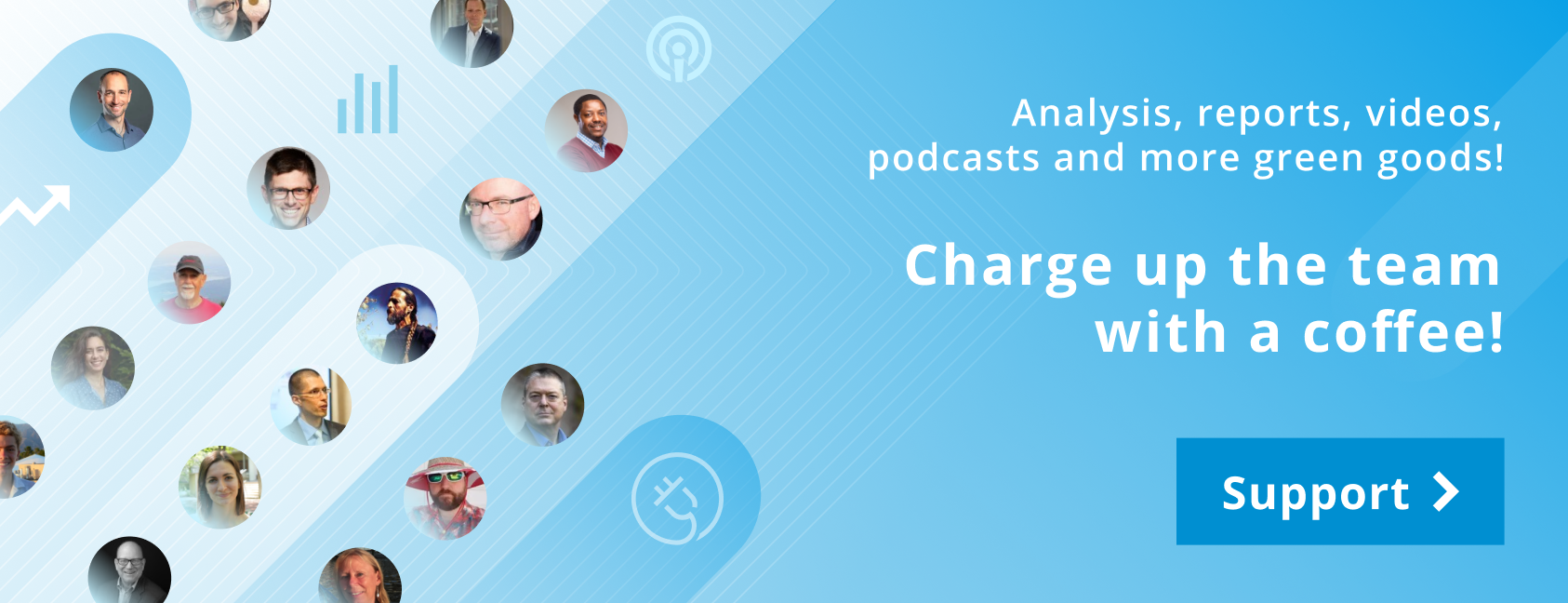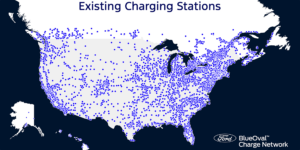
On April 6, Vice President Kamala Harris visited the state of Georgia to announce that South Korean solar cell manufacturer Qcells and Virginia-based Summit Ridge Energy plan to deploy 1.2 gigawatts of community solar power in the United States — enough clean energy to power 140,000 homes and businesses. The project will require the manufacture of 2.5 million solar panels — the largest community solar order in US history.
Harris and other government officials are fanning out across America as part of what is being billed by the White House as its “Invest in America” tour. Community solar generally refers to local solar facilities shared by community subscribers who receive credit on their energy bills for their share of the power produced. Community solar results in an average of 10% in annual savings for customers, White House officials said, and provides clean energy benefits to renters and those without access to rooftop solar, according to CNBC.
In January, Qcells announced it would invest $2.5 billion to build two new US factories in Georgia, one in Cartersville and the other near an existing facility in Dalton, which Qcells called “the largest clean energy investment in American history.” The Cartersville factory will be used primarily to convert raw silicon into polysilicon which will then be turned into ingots. Those ingots are then sliced into wafers that are converting converted into the solar cells that make solar panels or modules. When complete, the two new Qcells factories are expected to employ more than 2,600 workers.
The company projects it will supply about 30% of total U.S. demand for solar panels by 2027. The new plan is being driven by tax credits provided by the Inflation Reduction Act signed into law last year. The new panels will likely be used for community solar projects proposed for Illinois, Maine, and Maryland.
The big story here is that the vast majority of the steps needed to make a solar panel — from producing raw silicon to making solar cells — take place in China today. Qcells has been talking about expanding its operations in Georgia for over a year, but what got it to move forward was the Inflation Reduction Act. Under the 45X production tax credit structure created by the IRA, each domestically produced part of the solar manufacturing process will receive its own tax benefits, Scott Moskowitz, head of market strategy and public affairs for Qcells, told Canary Media.
Solar modules and cells will receive 7 cents and 4 cents per watt of generation capacity, respectively. Crystalline silicon wafers and ingots, solar grade polysilicon, and silicon metal will receive credits based on the volume of production. The goal of this tax credit structure, first put forward by Georgia senators Jon Ossoff and Raphael Warnock and known as the Solar Energy Manufacturing for America Act, is to make each stage of the solar production process cost competitive with materials and products coming from overseas.
“All these credits stack,” Moskowitz said, with each stage in the process adding tax credit value to the final product. Taken together, they could cover about half the cost of producing a solar panel. “What SEMA was designed to do is make U.S. solar manufacturing and products competitive with anyplace in the world,” Moskowitz added.
Community Solar & Jobs
Speaking in Dalton, Georgia this week, Vice President Harris told the audience, “What kind of jobs are we talking about? We’re talking about the jobs that are the skills that are required to be a technician, an engineer, an IT specialist, a data analyst. Jobs that give folks the opportunity to grow and advance right here in the community. And jobs that help our nation fight the climate crisis.”
Since the passage of the Inflation Reduction Act last year, more than 100,000 clean energy jobs have been announced in 31 states with over 90 new clean energy projects in small towns and bigger cities nationwide totaling $89.5 billion in new private sector investments, according to Climate Power. Which is interesting, since while the administration is working to create jobs, the Federal Reserve is working just as hard to put more Americans out of work so the banks, investment houses, and wealthy Americans won’t see the worth of their massive financial holdings eroded by the scourge of inflation. Politics is a strange and scary place.
Policies Matter
As a backdrop to the administration’s plans to expand community solar, it also is wrestling with the consequences of a trade case brought by tiny Auxin Solar. Auxin claims that its business is being hurt by cheap imports from China, which heavily subsidizes its solar panel industry. No doubt Auxin’s claim has some merit. Following the Soyndra debacle during the Obama administration, the US virtually abandoned the idea of manufacturing solar panels domestically. The nation was practically begging China to make them for us and the Chinese were only too glad to accept America’s offer.
Now the wheel has turned and America is shocked — SHOCKED! — to learn that it cannot possibly manufacture all the solar panels it needs to transition to a clean energy economy. And yet, the Commerce Department has slapped punitive tariffs on some Chinese-made solar panels. China has outsourced some panel production to other Asian countries like Vietnam, Cambodia, Thailand, and Malaysia. The Biden administration put a two year pause on those tariffs last summer, but there are those in Congress who want to see that pause rescinded.
According to Canary Media, the Congressional push to undo the pause will likely fail, but the mere threat of higher tariffs is enough to send the solar industry into a tizzy. Think about it. If you are a solar developer trying to figure out how to build a solar project that will operate for the next 20 years and do it profitably, being unable to predict how much you will have to pay for a couple hundred thousand — a few million — solar panels is not the kind of uncertainty you want. The economic viability of a solar project is figured down to the hundredth of a penny. Change your input costs and the entire project becomes much more risky.
Solar panel factories don’t grow on trees, and there aren’t any unused factories laying around that could start cranking out solar panels tomorrow. It will take years to build a US solar panel manufacturing capability. QCells says it will be able to supply 30% of America’s needs, but where are the other 70% going to come from?
Americans want domestically manufactured solar panels, but only want to pay what those heavily subsidized panels from China and Asia cost. That’s a problem. In effect, the IRA is offering domestic subsidies to offset the subsidies available elsewhere. It is all well and good to tout a new investment in America, but there is a lot of hard work that remains to be done before the country will have an established solar panel manufacturing base making products that are competitive with those produced in other countries. Stay tuned. The end of this story has yet to be written.
I don't like paywalls. You don't like paywalls. Who likes paywalls? Here at CleanTechnica, we implemented a limited paywall for a while, but it always felt wrong — and it was always tough to decide what we should put behind there. In theory, your most exclusive and best content goes behind a paywall. But then fewer people read it! We just don't like paywalls, and so we've decided to ditch ours. Unfortunately, the media business is still a tough, cut-throat business with tiny margins. It's a never-ending Olympic challenge to stay above water or even perhaps — gasp — grow. So ...
- SEO Powered Content & PR Distribution. Get Amplified Today.
- Platoblockchain. Web3 Metaverse Intelligence. Knowledge Amplified. Access Here.
- Source: https://cleantechnica.com/2023/04/07/qcells-lands-largest-community-solar-order-in-us-history/
- :is
- 000
- 1
- 100
- 20 years
- 7
- 9
- a
- Able
- About
- about IT
- above
- Accept
- access
- According
- across
- Act
- added
- administration
- advance
- All
- always
- america
- American
- Americans
- analyst
- and
- Announce
- announced
- annual
- April
- ARE
- around
- AS
- asia
- asian
- At
- available
- average
- backdrop
- Banks
- base
- based
- BE
- becomes
- before
- behind
- being
- benefit
- benefits
- BEST
- biden
- Biden Administration
- Big
- bigger
- Billion
- Bills
- Bit
- brought
- build
- business
- businesses
- button
- by
- called
- Cambodia
- cannot
- Capacity
- case
- Cells
- challenge
- change
- cheap
- China
- chinese
- chip
- Cities
- claim
- claims
- clean energy
- Climate
- climate crisis
- CNBC
- COM
- come
- coming
- Commerce
- community
- company
- competitive
- complete
- Congress
- Congressional
- Consequences
- content
- convert
- converted
- Cost
- Costs
- could
- countries
- country
- Couple
- cover
- create
- created
- credit
- Credits
- crisis
- Customers
- data
- data analyst
- decide
- decided
- Demand
- Department
- deploy
- designed
- Developer
- Domestic
- domestically
- Dont
- doubt
- down
- driven
- during
- each
- Economic
- economy
- effect
- elsewhere
- energy
- energy projects
- engineer
- enough
- Entire
- established
- Ether (ETH)
- Even
- Exclusive
- existing
- expanding
- expected
- facilities
- Facility
- factories
- factory
- FAIL
- Federal
- federal reserve
- few
- fight
- Figure
- figured
- final
- financial
- First
- following
- For
- Forward
- from
- generally
- generation
- Georgia
- Give
- goal
- Goes
- going
- good
- Government
- Government Officials
- grade
- Grow
- Half
- Hard
- hard work
- Have
- head
- heavily
- help
- here
- higher
- history
- Holdings
- Homes
- House
- houses
- How
- How To
- HTML
- http
- HTTPS
- Hurt
- idea
- illinois
- image
- implemented
- important
- imports
- in
- In other
- industry
- inflation
- input
- interesting
- investment
- Investments
- IRA
- IT
- IT specialist
- ITS
- January
- Jobs
- jpg
- Kamala Harris
- Kind
- known
- Korean
- lands
- largest
- Last
- Last Year
- Law
- LEARN
- like
- likely
- Limited
- local
- Lot
- Maine
- Majority
- make
- Making
- Malaysia
- manufactured
- Manufacturer
- manufacturing
- margins
- Market
- Maryland
- massive
- materials
- max-width
- Media
- Merit
- metal
- million
- Modules
- monthly
- more
- most
- move
- move forward
- nation
- Nationwide
- Near
- needed
- needs
- New
- new investment
- next
- Obama
- of
- offer
- offering
- offset
- Olympic
- on
- ONE
- operate
- Operations
- Opportunity
- order
- Other
- overseas
- own
- panel
- panels
- part
- Patreon
- Pay
- PayPal
- People
- perhaps
- Place
- plan
- plans
- plato
- Plato Data Intelligence
- PlatoData
- please
- politics
- power
- practically
- predict
- president
- primarily
- private
- private sector
- Problem
- process
- Produced
- Product
- Production
- Products
- project
- projects
- proposed
- provided
- provides
- public
- Push
- put
- Raw
- Read
- receive
- refers
- remains
- Renewable
- renewable energy
- renters
- require
- required
- Reserve
- resource
- respectively
- Results
- Risky
- s
- Said
- Savings
- says
- sector
- SENATORS
- Share
- shared
- shocked
- should
- signed
- Silicon
- since
- skills
- small
- So
- Social
- solar
- Solar cells
- solar energy
- solar panel
- solar panels
- Solar Power
- some
- South
- south korean
- specialist
- stack
- Stage
- start
- State
- States
- stay
- Steps
- Still
- Story
- Strategy
- structure
- subscribers
- summer
- Summit
- supply
- support
- Take
- talking
- tariffs
- tax
- tax credit
- team
- Thailand
- that
- The
- The State
- the world
- their
- Them
- There.
- These
- this week
- threat
- to
- today
- together
- tomorrow
- too
- Total
- Tour
- towns
- trade
- transition
- Trees
- Turned
- u.s.
- Uncertainty
- under
- United
- United States
- unused
- us
- value
- Vast
- Ve
- via
- viability
- Vice President
- Vietnam
- virtually
- visited
- volume
- Water
- Way..
- week
- WELL
- What
- What is
- Wheel
- which
- while
- white
- White House
- WHO
- will
- with
- without
- Work
- workers
- working
- world
- worth
- would
- written
- Wrong
- year
- years
- Your
- zephyrnet








